Mirella Sichirollo Patzer's Blog, page 11
April 7, 2016
The Hanging of Mary Surratt
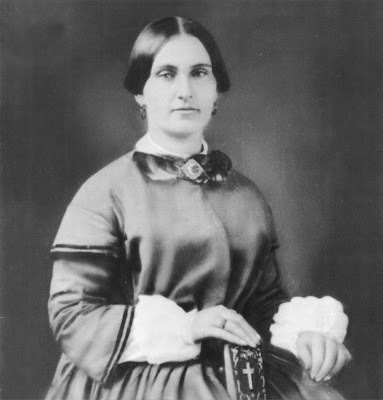 On July 7, 1865, Mary Elizabeth Jenkins Surrat, a Catholic boarding house owner, was convicted of conspiring to assassinate President Abraham Lincoln. Sentenced to death, and plagued with great pain and illness due menstral complications, she was hanged, becoming the first woman executed by the United States federal government. Her son, John H. Surratt, Jr., a true conspirator who brought the other conspirators into Mary's boarding house, was later tried but was not convicted of involvement in the assassination. This is her story.
On July 7, 1865, Mary Elizabeth Jenkins Surrat, a Catholic boarding house owner, was convicted of conspiring to assassinate President Abraham Lincoln. Sentenced to death, and plagued with great pain and illness due menstral complications, she was hanged, becoming the first woman executed by the United States federal government. Her son, John H. Surratt, Jr., a true conspirator who brought the other conspirators into Mary's boarding house, was later tried but was not convicted of involvement in the assassination. This is her story. Mary Surratt
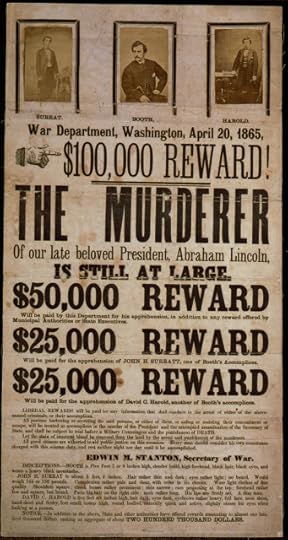
To this very day, much controversy exists about the guilt of Boardinghouse innkeeper Mary Surratt, who was put on trial, convicted and executed for conspiring to assassinate President Lincoln.
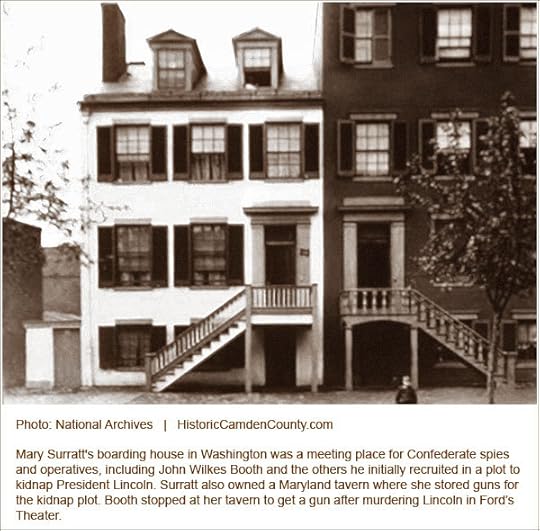
Mary's Boarding House
As the owner of a boarding house where the conspirators, friends of her son, often met, she was insidiously connected to Lincoln's assassination.
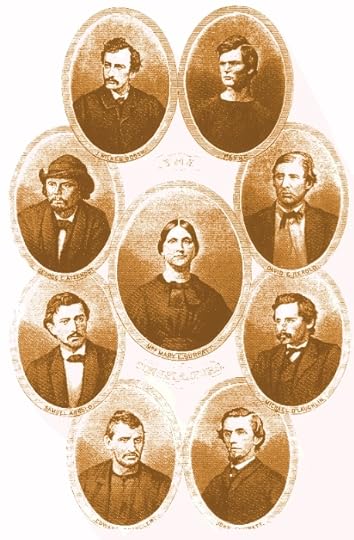
Much has been written of her connection to this heinous crime and the hasty put together trial and lack of adequate defense that saw her hanged, even though numerous attempts to secure clemency for her by President Andrew Johnson.
Within two months of being charged with the crime she would be dead; swinging from the gallows in Washington D.C.
Before the ink could dry on her execution order, construction of the gallows began. It was 12 feet high and 20 square feet. In charge of all the preparations was a man named Captain Christian Rath. With great care, he made the nooses. Convinced the government would never hang a woman, he made Surratt's noose the night before the execution with five loops rather than the regulation seven. On the night before the executions, he tied each noose to a tree limb and a bag of buckshot, and then tossed the bags to the ground. All nooses held tight and passed the test. When civilian grave diggers refused to dig the graves out of superstition and fear, Rath asked soldiers to volunteer. A large number of soldiers eagerly accepted.
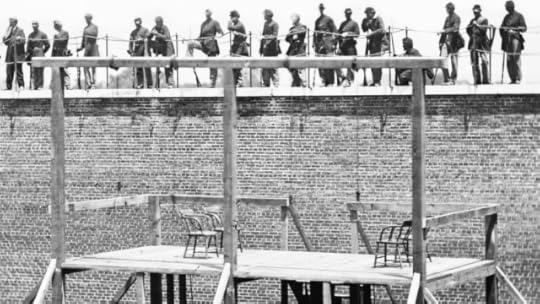
The Empty Scaffold and Gallows
At 12:00 PM on July 6, Surratt was informed she would be hanged the next day. She wept copiously. In her cell, by her side were two Catholic priests and her daughter Anna. As she waited for her death, her menstrual problems had worsened, and she was in such pain and suffered from such severe cramps that the prison doctor gave her wine and medication to help ease her suffering. The entire time, she continually and vehemently championed her innocence. She spent the night on her mattress, weeping and moaning (in pain and grief), ministered to by Anna and the priests.
At 8:00 AM. on July 7, Anna left her mother's side and hurried to the White House in a desperate attempt to beg for her mother's life. President Johnson refused to see her. Anna returned to her mother's cell at about 11:00 AM.
At 11:25 AM, the soldiers began testing the gallows; the sound terrifying and unnerving to the condemned. Shortly before noon, Mary was taken from her cell and then allowed to sit in a chair near the entrance to the courtyard. It was a hot, oppressive day. The temperature was 92.3 °F or 33.5 °C.
At 12:30 PM, the guards ordered all visitors to leave. Forced to part from her mother, Anna's hysterical screams of grief could be heard throughout the prison. Mary's lawyers made desperate attempts to save Mary's life. One court writ was successful, but President Johnson promptly cancelled it. The hanging was to proceed.
At 1:15 PM, Mary and the other three condemned prisoners were escorted through the courtyard. Her ankles and wrists manacled, Mary was first to climb the scaffold steps. She wore a black bombazine dress, a black bonnet, and black veil.
Attendance at the hanging had been limited. Only those who had good reason to be there were allowed a ticket. More than 1,000 people comprised of government officials, members of the U.S. armed forces, friends and family of the accused, official witnesses, and reporters stood in the hot sun to watch. Attendance had been limited. The photographer who had photographed the body of Booth and taken portraits of several of the male conspirators while they were imprisoned aboard naval ships was hired by the government to photograph the execution.
The Order for Execution was read. Mary, either weak from her illness or swooning in fear (perhaps both), had to be supported by two soldiers and her priests. The condemned were seated in chairs, Surratt almost collapsing into hers. She was seated to the right of the others, the traditional "seat of honor" in an execution. An umbrella was brought to help shield Mary from the baking sun.
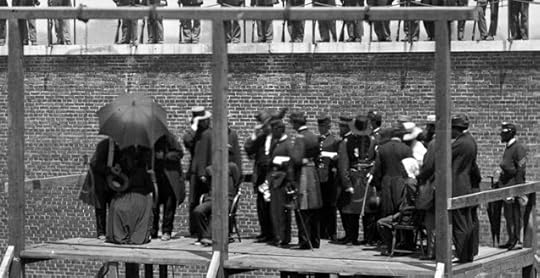
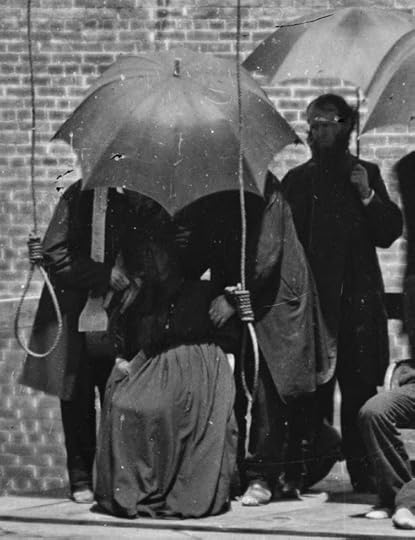
White bindings were used to tie their arms to their sides, and their ankles and thighs together. The cloths around Surratt's legs were tied around her dress below the knees.
Each condemned was ministered to by a member of the clergy. From the scaffold, Powell, one of the other condemned men said, "Mrs. Surratt is innocent. She doesn't deserve to die with the rest of us".
The two priests prayed over Mary Surratt, and held a crucifix to her lips. 16 minutes was all it took to prepare the prisoners for execution.
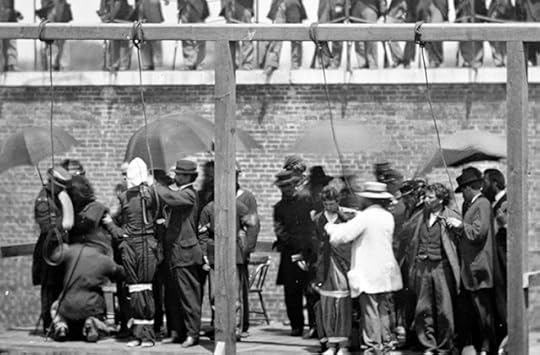
A white bag was placed over the head of each prisoner after the noose was put in place. They removed Mary's bonnet and placed the noose around her neck. When she complained that the bindings around her arms hurt, an officer said, "Well, it won't hurt long."
Finally, the prisoners were asked to stand and move forward a few feet to the nooses. The chairs were removed. Mary Surratt's last words, spoken to a guard as he moved her forward to the drop, were "Please don't let me fall." Surratt and the others stood on the drop for about 10 seconds.
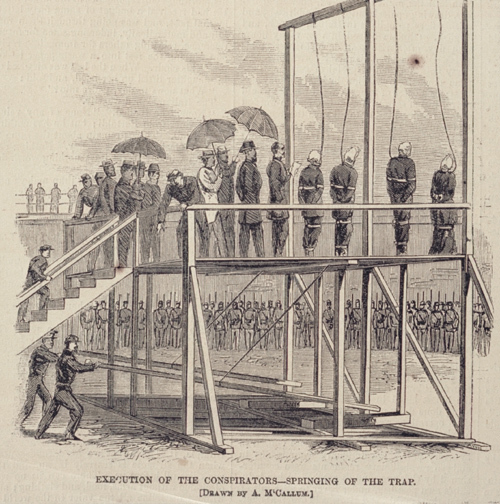
Th Captain clapped his hands. Four soldiers knocked out the supports holding the drops in place, and the condemned fell. Surratt, who had moved forward enough to barely step onto the drop, lurched forward and slid partway down the drop—her body snapping tight at the end of the rope, swinging back and forth.
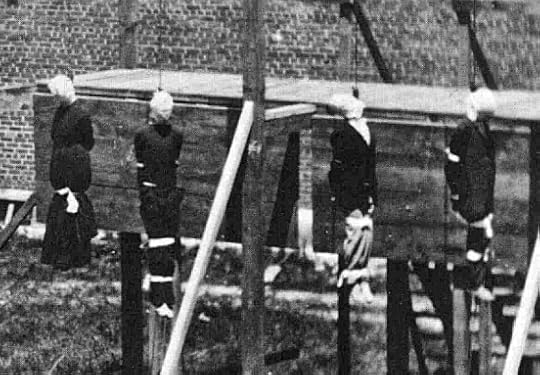
Surratt's death appeared to be the easiest. Atzerodt's stomach heaved once and his legs quivered, and then he was still. Herold and Powell struggled for nearly five minutes, strangling to death. The bodies were left to hang for 30 minutes. Afterwards, they were inspected by a physician to ensure that death had occurred.
At 1:53 PM the bodies were ordered to be cut down. A corporal raced to the top of the gallows and cut down Atzerodt's body, which fell to the ground with a thud. He was reprimanded, and the other bodies cut down more gently. Herold's body was next, followed by Powell's.
At 1:58 PM Mary's body was cut down. As her body was cut loose, her head fell forward. A soldier joked, "She makes a good bow". An officer immediately rebuked him for his poor sense of humor. The physical examinations determined that no one's neck had been broken by the fall. The manacles and cloth bindings were removed, but the white execution masks were left on. Each body was placed into a pine coffin. Each of the dead's names were recorded on a piece of paper, placed into a glass vial, and laid into the coffin beside them. The coffins were buried against the prison wall in shallow graves, just a few feet from the gallows. A white picket fence marked the burial site. That night, a mob attacked the Surratt boarding house and began stripping it of souvenirs until the police arrived to halt them. For 4 years, Anna begged for her mother's boy, but was denied. In October of 1867, the government decided to tear down the portion of the Washington Arsenal where the bodies of Surratt and the other executed conspirators lay. The coffins were disinterred and reburied in at another location at the Arsenal, with a wooden marker placed at the head of each burial vault. John Wilkes Booth's body lay alongside them. In February 1869, Edwin Booth asked President Johnson for the body of his brother, John Wilkes Booth. Johnson agreed to turn the body over to the Booth family, and on February 8 Mary Surratt's body was also turned over to Anna.Mary Surrat was buried in Mount Olivet Cemetery in Washington, D.C., on February 9, 1869.
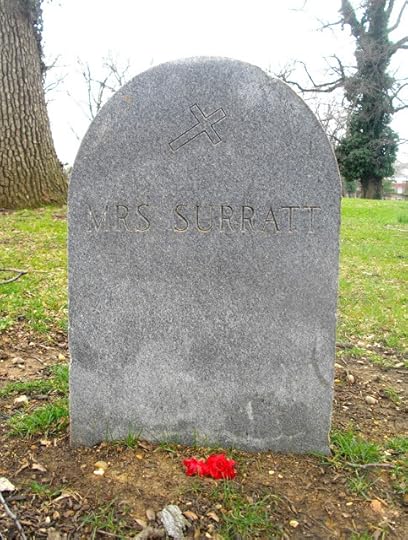

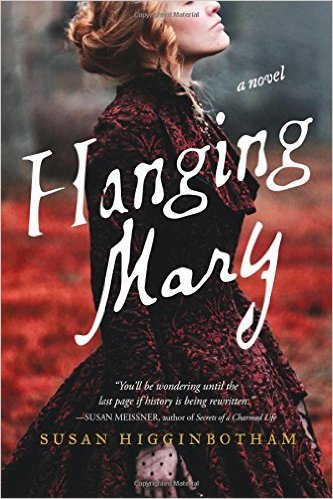 The untold story of Lincoln's Assassination
1864, Washington City. One has to be careful with talk of secession, of Confederate whispers falling on Northern ears. Better to speak only when in the company of the trustworthy. Like Mrs. Surratt.A widow who runs a small boardinghouse on H Street, Mary Surratt isn't half as committed to the cause as her son, Johnny. If he's not delivering messages or escorting veiled spies, he's invited home men like John Wilkes Booth, the actor who is even more charming in person than he is on the stage.But when President Lincoln is killed, the question of what Mary knew becomes more important than anything else. Was she a cold-blooded accomplice? Just how far would she go to help her son?Based on the true case of Mary Surratt, Hanging Mary reveals the untold story of those on the other side of the assassin's gun.
The untold story of Lincoln's Assassination
1864, Washington City. One has to be careful with talk of secession, of Confederate whispers falling on Northern ears. Better to speak only when in the company of the trustworthy. Like Mrs. Surratt.A widow who runs a small boardinghouse on H Street, Mary Surratt isn't half as committed to the cause as her son, Johnny. If he's not delivering messages or escorting veiled spies, he's invited home men like John Wilkes Booth, the actor who is even more charming in person than he is on the stage.But when President Lincoln is killed, the question of what Mary knew becomes more important than anything else. Was she a cold-blooded accomplice? Just how far would she go to help her son?Based on the true case of Mary Surratt, Hanging Mary reveals the untold story of those on the other side of the assassin's gun.Review
Author Susan Higginbotham has written an very real, in-your-face, interpretation of the events leading to President Abraham Lincoln's assassination told through the point of view of Mary Surratt and the conspirators. From start to finish, she captured the historical era brilliantly. We see how easy it was to walk to the White House to stroll its lawns and pathways to wait for the president to appear with a speech. She describes how the aftermath of the Civil War affected Americans, both in the north and south, while capturing societal norms and rules.
To say this novel stirs up the reader's emotions would be an understatement. I could not help but feel empathy for Mary whose son was conspiring to kidnap Abraham Lincoln. He brought his co-conspirators into her home, and without telling her much, preyed on her good nature and kindness to do them some favors which turned out to cause her great harm, and which ultimately saw her hung. In the aftermath of the assassination, her cowardly son fled to Canada, and while his mother faced execution, he did not return to aid her in her defense. His word could have saved her. But he didn't do anything on her behalf. When he finally was caught, he was acquitted and did not suffer the same fate as his mother.
Of all Susan Higginbotham's books, this is by far her best. Unlike some of her other novels where there are sometimes too many characters to fully keep the story straight, this story is the opposite. There are slightly more than a handful of characters, and she brings them to life with great clarity and immense understanding. I loved this book and learning about Mary Surratt's dreadful story which continues to haunt me. It is one of the best books I've read this year and I rate it with a very strong 5 stars!
I received a copy of this novel through Netgalley in exchange for an honest and unbiased review.
For more historical bios visit http://www.historyandwomen.com, and for more compelling historical novel reviews, join me at http://greathistoricals.blogspo.com.










Published on April 07, 2016 14:00
March 30, 2016
The deathbed promise of Martha (Patsy) Jefferson Randolf
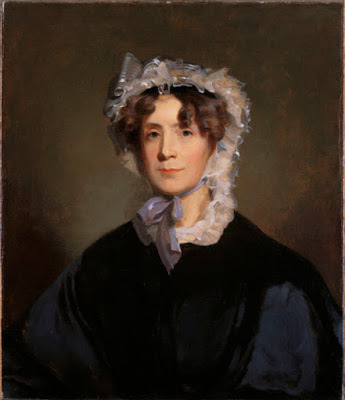 Martha (Patsy) Jefferson Randolph was a daughter utterly devoted to her father, Thomas Jefferson. When her mother, Martha Wayles Skelton Jefferson died, she made a death bed promise to take care of her father. Her father was a prominent politician, a southerner, and slave owner. She and her father moved to Paris as U.S. Minister to France when she was 12. Paris was not only cultural, but it was a political hotbed - anti-nobility and the dreaded guillotine and all that! Despite the fact they were staunch protestants her father enrolled her at an famous and exclusive convent after being reassured she would not have to indulge in any Catholic teachings. Patsy, however, took to convent life, and when she expressed a desire to become a nun, her father swiftly removed her. Upon their return to America, she married Thomas Mann Randolf Jr., a planter, a politician, and later the governor of Virginia.
Martha (Patsy) Jefferson Randolph was a daughter utterly devoted to her father, Thomas Jefferson. When her mother, Martha Wayles Skelton Jefferson died, she made a death bed promise to take care of her father. Her father was a prominent politician, a southerner, and slave owner. She and her father moved to Paris as U.S. Minister to France when she was 12. Paris was not only cultural, but it was a political hotbed - anti-nobility and the dreaded guillotine and all that! Despite the fact they were staunch protestants her father enrolled her at an famous and exclusive convent after being reassured she would not have to indulge in any Catholic teachings. Patsy, however, took to convent life, and when she expressed a desire to become a nun, her father swiftly removed her. Upon their return to America, she married Thomas Mann Randolf Jr., a planter, a politician, and later the governor of Virginia.
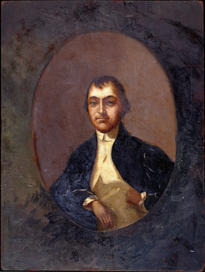
Thomas Mann Randolf Jr
Despite their often turbulent marriage, she bore him twelve children. Drinking, family scandals, financial problems, and resentment towards Patsy's unwavering and constant devotion to her father, took their toll.

Thomas JeffersonFounding Father
When her father was president, she shared her time between her home and the White House, as she balanced her large family, running a plantation and slaves, home schooling her children, and being a political wife. But she was always first and foremost in his life, hiding his scandals (that he was a slave owner and that he had a black mistress and illegitimate children). Her husband's drinking steadily became worse, and with it, he became unreliable, aloof, and mentally unstable. They separated. She then turned her entire focus to her beloved father until his death. He left her his entire estate, and their beloved home Monticello, along with his numerous, heavy debts. Upon the death of her estranged husband, Patsy struggled to make ends meet.

MonticelloIn an effort to save Monticello from being seized by creditors, Patsy sold the 130 slaves that came with the estate. The state legislatures of South Carolina and Louisiana each donated $10,000 to her for her support. But sadly, it was not enough and she was forced to sell her family home several years later. She lived her later years modestly until she died at their Edgehill estate in Albemarle County, Virginia.Her life story has been lovingly and impeccably recreated in an exciting new novel by Stephanie Dray and Laura Kamoie. And it is definitely one of the best books I've ever read!
AMERICA'S FIRST DAUGHTER
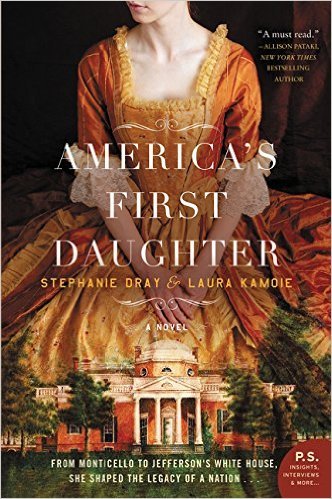 In a compelling, richly researched novel that draws from thousands of letters and original sources, bestselling authors Stephanie Dray and Laura Kamoie tell the fascinating, untold story of Thomas Jefferson’s eldest daughter, Martha “Patsy” Jefferson Randolph—a woman who kept the secrets of our most enigmatic founding father and shaped an American legacy.
From her earliest days, Patsy Jefferson knows that though her father loves his family dearly, his devotion to his country runs deeper still. As Thomas Jefferson’s oldest daughter, she becomes his helpmate, protector, and constant companion in the wake of her mother’s death, traveling with him when he becomes American minister to France.It is in Paris, at the glittering court and among the first tumultuous days of revolution, that fifteen-year-old Patsy learns about her father’s troubling liaison with Sally Hemings, a slave girl her own age. Meanwhile, Patsy has fallen in love—with her father’s protégé William Short, a staunch abolitionist and ambitious diplomat. Torn between love, principles, and the bonds of family, Patsy questions whether she can choose a life as William’s wife and still be a devoted daughter.Her choice will follow her in the years to come, to Virginia farmland, Monticello, and even the White House. And as scandal, tragedy, and poverty threaten her family, Patsy must decide how much she will sacrifice to protect her father's reputation, in the process defining not just his political legacy, but that of the nation he founded.
In a compelling, richly researched novel that draws from thousands of letters and original sources, bestselling authors Stephanie Dray and Laura Kamoie tell the fascinating, untold story of Thomas Jefferson’s eldest daughter, Martha “Patsy” Jefferson Randolph—a woman who kept the secrets of our most enigmatic founding father and shaped an American legacy.
From her earliest days, Patsy Jefferson knows that though her father loves his family dearly, his devotion to his country runs deeper still. As Thomas Jefferson’s oldest daughter, she becomes his helpmate, protector, and constant companion in the wake of her mother’s death, traveling with him when he becomes American minister to France.It is in Paris, at the glittering court and among the first tumultuous days of revolution, that fifteen-year-old Patsy learns about her father’s troubling liaison with Sally Hemings, a slave girl her own age. Meanwhile, Patsy has fallen in love—with her father’s protégé William Short, a staunch abolitionist and ambitious diplomat. Torn between love, principles, and the bonds of family, Patsy questions whether she can choose a life as William’s wife and still be a devoted daughter.Her choice will follow her in the years to come, to Virginia farmland, Monticello, and even the White House. And as scandal, tragedy, and poverty threaten her family, Patsy must decide how much she will sacrifice to protect her father's reputation, in the process defining not just his political legacy, but that of the nation he founded.I cannot stop raving about this book. Not only is it well-researched, it is filled with conflict, scandal, and secrets. As slave ownership was swiftly falling out of favor, Thomas Jefferson and his daughter Patsy did everything they could to keep their family secrets secret! Troubles always haunted this family, making this a terrific page turner. Coupled with gorgeously beautiful prose, I must say that this is one of the best books I have ever read! It is nothing short of brilliant! Get it! Get it now! You won't be sorry!










Published on March 30, 2016 12:07
March 14, 2016
The Marriages and Scandals of Lucrezia Borgia (1480 - 1519)
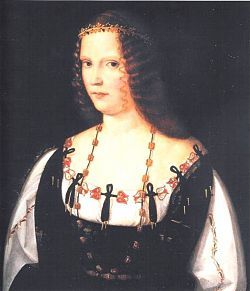 Lucrezia Borgia
Lucrezia BorgiaPainting by Bartolomeo Veneziano
Twenty-eleven was a good year for the Borgias, who were depicted in not one but two television shows. In fact, I was bored at home with Netflix one night when I decided to watch Jeremy Irons play Rodrigo in Showtime’s The Borgias, only to discover that the show on Netflix was not The Borgias but Borgia, an entirely separate show produced by Canal Plus.
Neither show is for the faint of heart, as stories about the Borgia are generally told with a sneer or a blush. Lucrezia’s life was none too pious and, as with many women of the era, she was played like a chess piece by the men in her family. This is not to say, of course, that Lucrezia didn’t have a few tricks of her own—namely the rumored empty ring on her hand she often filled with poison.
The Fairest of All
Rumors riddle Lucrezia’s biography, but certain things are clear: she was born in 1480 an illegitimate daughter of Rodrigo Borgia, later the corrupt Pope Alexander VI.
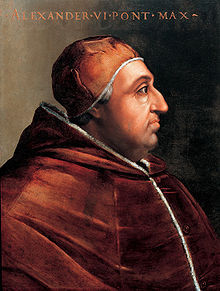
Pope Alexander VI
She bedazzled onlookers with her hazel eyes, perfect complexion, and waves of golden hair that fell past her knees as she walked gracefully down the aisle with her first husband Giovanni Sforza.
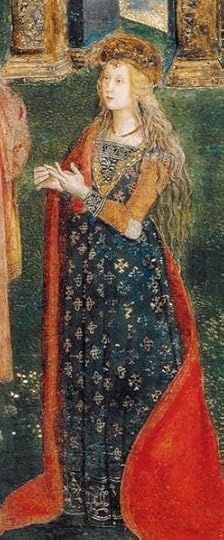
Lucrezia Borgia

Giovanni SforzaCondottiere and Lord of Pesaro and Gradara
The marriage was more an alliance—when Rodrigo became Pope Alexander VI, he needed strong allies like the Sforza family, even if it meant annulling Lucrezia’s previous engagement to a lord in Valencia.
The Unconsummated Marriage
Eventually, the pope no longer needed the Sforzas. While many theories abound regarding the divorce, it is generally accepted that when the pope ordered Giovanni’s quiet execution, Cesare informed his sister and Lucrezia convinced her husband to flee Rome.

Cesare Borgia
Another popular (and perhaps juicier) rumor, however, is that Cesare and Lucrezia were having an incestuous affair and Giovanni simply needed eliminating, even if it meant putting words into the pope’s mouth. Either way, the pope claimed the marriage had not been consummated, that it was invalid, and that his daughter was free to “choose” her next husband, never mind that she was supposedly pregnant at the time of the annulment.
The Fruit of Said Unconsummated Marriage
Lucrezia awaited the divorce at the convent of San Sisto and there, before her marriage to Alfonso of Aragon, allegedly gave birth to a son named Giovanni, known today as Roman Infante. It was not long before two papal bulls were issued concerning little Giovanni, neither of them mentioning Lucrezia as his mother—one, that he was Cesare’s child from an affair before his marriage, and another that Giovanni was Pope Alexander’s child. It was assumed at the time that Giovanni’s was Cesare’s brood, but Giovanni later stayed with Lucrezia in Ferrara, where he was accepted as her half-brother.

Giovanni Borgia
A Pearl Among Women
When her second husband died, Lucrezia was handed to Alfonso d’Este, Duke of Ferrara, with whom she had numerous children and besides whom she had many extramarital affairs.
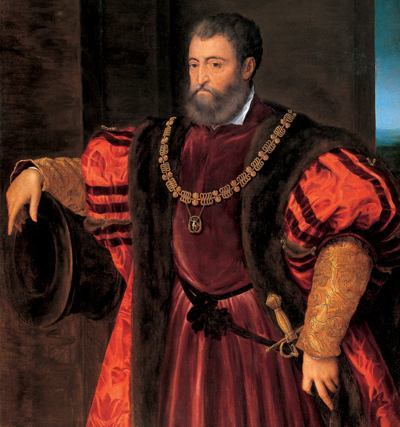
Alfonso d'Este
These included her married brother-in-law, who later contracted syphilis and kindly ended matters with Lucrezia, as well as the noted French soldier, the Chevalier Bayard, who described her as a “pearl among women.”
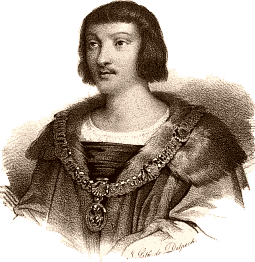
Chevalier Bayard
Lucrezia died in October 1519 at the age of 39 after the complicated birth of her eight child and buried in the convent of Corpus Domini. Her legacy—beauty, incest, murder, passionate affairs, and perhaps above all courage, or rather nerve—is one that fascinates historians, storytellers, and gossips alike. She did, after all, survive the fall of the Borgias after Pope Alexander VI’s death. The same cannot be said for everyone.
Amanda Tradwick is a grant researcher and writer for CollegeGrants.org. She has a Bachelor's degrees from the University of Delaware, and has recently finished research on college grants for minorities and vermont education grants.
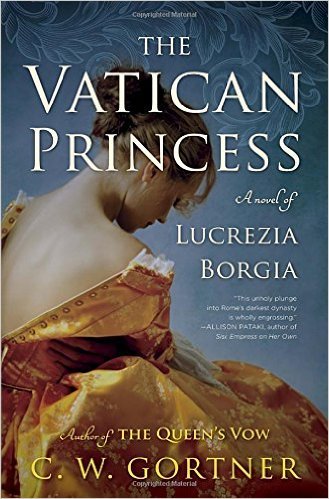 For fans of Philippa Gregory and Alison Weir, bestselling author C. W. Gortner effortlessly weaves history and drama in this captivating novel about one of the world’s most notorious families. Glamorous and predatory, the Borgias fascinated and terrorized fifteenth-century Italy, and Lucrezia Borgia, beloved daughter of the pope, was at the center of the dynasty’s ambitions. Slandered as a heartless seductress who lured men to their doom, was she in fact the villainess of legend, or was she trapped in a familial web, forced to choose between loyalty and survival?
For fans of Philippa Gregory and Alison Weir, bestselling author C. W. Gortner effortlessly weaves history and drama in this captivating novel about one of the world’s most notorious families. Glamorous and predatory, the Borgias fascinated and terrorized fifteenth-century Italy, and Lucrezia Borgia, beloved daughter of the pope, was at the center of the dynasty’s ambitions. Slandered as a heartless seductress who lured men to their doom, was she in fact the villainess of legend, or was she trapped in a familial web, forced to choose between loyalty and survival?With the ascension of the Spaniard Rodrigo Borgia as Pope Alexander VI, a new era has dawned in Rome. Benefitting from their father’s elevation are the new pope’s illegitimate children—his rival sons, Cesare and Juan, and beautiful young daughter Lucrezia—each of whom assumes an exalted position in the papal court. Privileged and adored, Lucrezia yearns to escape her childhood and play a part in her family’s fortunes. But Rome is seductive and dangerous: Alliances shift at a moment’s notice as Italy’s ruling dynasties strive to keep rivals at bay. As Lucrezia’s father faces challenges from all sides, the threat of a French invasion forces him to marry her off to a powerful adversary. But when she discovers the brutal truth behind her alliance, Lucrezia is plunged into a perilous gambit that will require all her wits, cunning, and guile. Escaping her marriage offers the chance of happiness with a passionate prince of Naples, yet as scandalous accusations of murder and incest build against her, menacing those she loves, Lucrezia must risk everything to overcome the lethal fate imposed upon her by her Borgia blood.
Beautifully wrought, rich with fascinating historical detail, The Vatican Princess is the first novel to describe Lucrezia’s coming-of-age in her own voice. What results is a dramatic, vivid tale set in an era of savagery and unparalleled splendor, where enemies and allies can be one and the same, and where loyalty to family can ultimately be a curse.
Review:
Lucrezia Borgia continues to fascinate readers centuries after the Italian Renaissance. The scandals, sexual escapades, incest, failed marriages, murders, and intrigues from all members of the Borgia family and those closest to them seems almost too crazy to believe. How much is truth and how much is legend? Were they victims of slander by their enemies? Only the Borgias will ever truly know.
As the doted upon bastard child of Pope Alexander VI, and younger sister to Cesare and Juan Borgia, and because of her great beauty, she easily became prey to the political aspirations of her male relatives.
In the recently released novel, THE VATICAN PRINCESS, author Christopher Gortner writes a rich first person narrative about Lucrezia’s life whereby he truly brings to vibrant life all the colors of the Italian Renaissance. In Gortner’s version of Lucrezia and her family, we read a tamer version of the legendary events that framed her life. He strongly portrays her as a good, much maligned heroine while painting the her father and brothers in a very dark light. His novel ends before Lucrezia’s third marriage to Alfonso d’Este, the Duke of Ferrara.
Even though the book does not encompass her entire life and cover all the intrigues that swirled about her and her family, I did enjoy Gornter’s version of her life. Lovely, flowing, first person prose with vivid descriptions of fashion and surrounds held my fascination to the end. Not my favourite novel about Lucrezia’s life, but a very good one!









Published on March 14, 2016 12:57
March 3, 2016
Lizzie Borden Took An Axe and Gave Her Mother 40 Whacks!
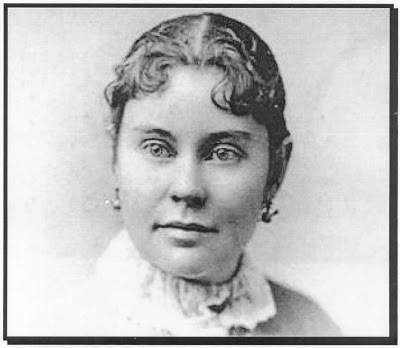
Lizzie Borden took an axe
And gave her mother forty whacks
And when she saw what she had done
She gave her father forty-one
To this very day, the horrific tale of Lizzie Borden is still talked about.
Lizzie Borden was born in Fall River, Massachusetts on July 19, 1860. When she was three years old, her mother Sarah Borden died, leaving both Lizzie and her elder sister, Emma motherless. Their father, Andrew Borden, soon remarried a woman named Abby Durfree Gray in 1865 and the newly formed family lived a relatively quiet life in their home on 92nd Street.
Lizzie and Emma grew to womanhood. Lizzie was a strong churgoer and taught Sunday School, belonged to Church organizations, and even travelled a little. Lizzie Borden's father was a hard working man and had acquired a significant amount of wealth, but he was stingy with his money, spending little, even refusing to add modern plumbing to their relatively nice home of decent size.
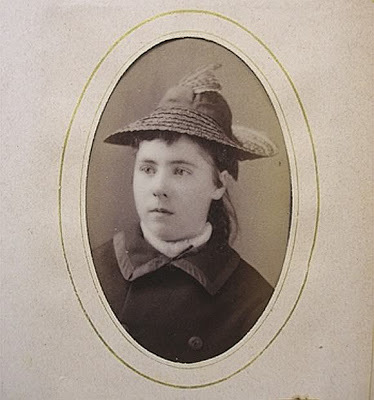
In 1884, Andrew bought his wife's half-sister a home. This incensed the two sisters who objected vehemently. Conflict within the home escalated. The siblings fought with their stepmother and referred to her as "Mrs. Borden" instead of "mother".
In an effort to eliminate the growing hostility between his daughters and his wife, Andrew gave Lizzie and Emma some money of their own and permitted them to rent out his old family home. But tension between the three women continued to grow. When some thefts were discovered from Andrew and Sarah's bedrooms, each member of the family bought and installed locks for all their bedroom doors.

In July of 1892, Lizzie and Emma went to visit some friends. Lizzie returned soon thereafter, but Emma remained. During the same time, Lizzie's uncle, the brother of her deceased mother, came to stay at the house for a visit. In early August, Andrew and Abby fell ill with an attack of vomiting. Abby confided to a friend that she suspected someone had poisoned her. On August 4, Lizzie's uncle and father went into town together. Andrew returned home without his brother-in-law and and lay down for a nap in the sitting room.
The family's maid was also taking a nap at this time and was awoken by Lizzie who urged her to come downstairs. Lizzie's father had been murdered, hacked in the face and head with an axe or hatchet. Lizzie said it happened while she was in the barn. The doctor was sent for. Upon his arrival, they discovered Abby dead in a bedroom, also hacked numerous times.
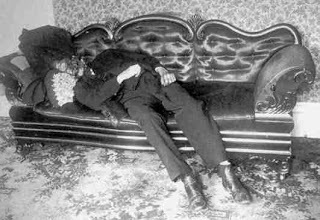
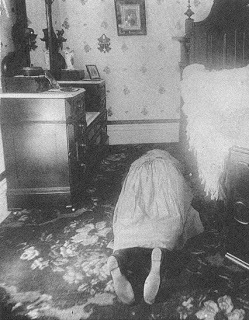
Andrew died without a will, therefore the entire estate, worth between $300,000 to $500,000, would go to Lizzie and Emma and not to Abby's heirs.
When evidence revealed that Lizzie had tried to burn a dress several days after the murder and that she'd tried to purchase poison, Lizzie Borden was arrested even though there was no bloodstained clothing found and only a washed, very clean hatchet made to look dirty was discovered in the cellar.
The widely publicized trial of Lizzie Borden commenced June 3, 1893 and popular opinion as to her innocence or guilt was split. Some Massachusetts feminists wrote in Lizzie Borden's favor and other townsfolk vehemently voiced their anger at her guilt.
Lizzie Borden never testified because she was adamant she had been in the barn searching for fishing equipment and eating pears outside while the murders were occuring. She insisted that she was innocent and kept her silence and allowed her lawyer to speak on her behalf.
Lack of direct evidence failed to convince the jury of her guilt and she was acquitted on June 20, 1893.
Afterwards, Lizzie continued to live in Fall River, but bought and lived in a new, much bigger home called "Maplecroft". She called herself Lizbeth instead of Lizzie. She and Emma lived in their new home together until they argued sometime in 1904 or 1905. Lizzie and Emma owned many pets, and left their estates to the Animal Rescue Leauge.

Lizzie Borden died at Fall River, Massachusetts, in 1927. She never outlived her notorious reputation as a murderess. She was buried next to her father and stepmother. The home in which the murders took place was turned into a bed-and-breakfast in 1992 and is now a popular tourist spot.
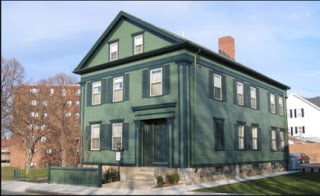
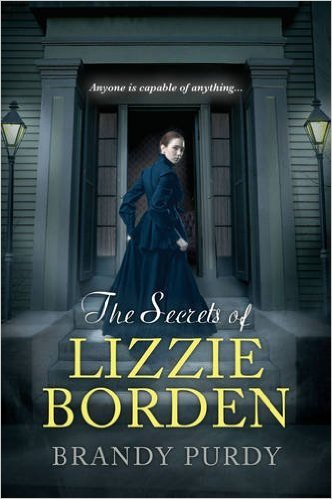 In her enthralling, richly imagined new novel, Brandy Purdy, author of The Ripper’s Wife, creates a compelling portrait of the real, complex woman behind an unthinkable crime.
In her enthralling, richly imagined new novel, Brandy Purdy, author of The Ripper’s Wife, creates a compelling portrait of the real, complex woman behind an unthinkable crime.Lizzie Borden should be one of the most fortunate young women in Fall River, Massachusetts. Her wealthy father could easily afford to provide his daughters with fashionable clothes, travel, and a rich, cultured life. Instead, haunted by the ghost of childhood poverty, he forces Lizzie and her sister, Emma, to live frugally, denying them the simplest modern conveniences. Suitors and socializing are discouraged, as her father views all gentleman callers as fortune hunters.
Lonely and deeply unhappy, Lizzie stifles her frustration, dreaming of the freedom that will come with her eventual inheritance. But soon, even that chance of future independence seems about to be ripped away. And on a stifling August day in 1892, Lizzie’s long-simmering anger finally explodes…
Vividly written and thought-provoking, The Secrets of Lizzie Borden explores the fascinating events behind a crime that continues to grip the public imagination—a story of how thwarted desires and desperate rage could turn a dutiful daughter into a notorious killer.
The story of Lizzie Borden and the murder of her parents have fascinated generations. Did she or didn't she do it? This question circulates to this very day. Now, Brandy Purdy has stepped up and wrote a compelling biographical novel about Lizzie Borden, her life, and her dark motivations. Anyone who reads a novel by Brandy Purdy must be prepared for a grippingly well told story that often bend the facts to enhance the story. And that's what I love most about Brandy Purdy! She knows how to spin a tale and make it soar. She definitely did just that with The Secrets of Lizzie Borden.
By using a very person, first personal narrative, the author knows how to delve deep inside her protaganists thoughts and emotions to make them larger than life, and that's what stands out the most about this novel. Lizzie Borden became so real that I truly felt I understood her and why she did what she did. I instinctively knew that I was not supposed to like or hate her - rather to comprehend her motivations.
This book definitely left me haunted, exposed to conflicting feelings of loathing and understanding. And that's the sign of a great book. For anyone who loves biographical murder mysteries and novels set in Victorian times, then this is a book you have to read. Compelling, engrossing, shocking! I loved it.









Published on March 03, 2016 09:00
March 2, 2016
Hilda of Northumbria - A Woman of Strength and Energy in the Dark Ages - The Abbess of Whitby
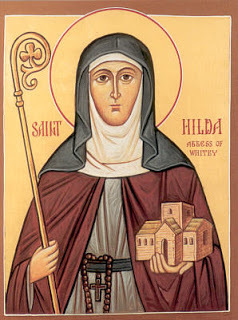 Hilda was born of the nobility during the early 7th century, on or around the year 614 A.D. Her father was the nephew of King Edwin of Northumbria. When she was an infant, her father was poisoned and died. King Edwin took her in and raised her. When King Edwin married a Christian woman, he saw to it that Hild was baptized along with him. From an early age, she was admired for her natural wisdom, respected by King Edwin and other noblemen. Despite all that rich attention, her passion was for the ordinary people. She was especially fond of a yung man named Caedmon, a lowly monk and cowheard at a nearby monastery. He loved to sing songs of praise to God, and Hild encouraged him in this. And although Hild had a strong and forceful personality, those who came in contact with her liked her charismatic character. At a time when Christianity was fighting for survival within a pagan world, Hild's passion for God and goodness gained her much respect. In 633, King Edwin was killed in battle. She was sent to live in the East Anglian court, and when her sister was widowed, Hild contemplated entering a convent in France with her sister. Instead, Hild heeded the advice of Bishop Aidan of Lindisfarne and returned to Northumbria where she took her vows as a nun. That decision would change her life. Within a year, she was made an abbess, and later founded the abbey at Whitby. For the last six years of her life, Hilda endured fevers and illness, yet continued to work throughout. She died at the age of sixty-six in November 680 A.D. On her deathbed with her final words, she urged the nuns in her charge to preserve peace among themselves and all others. Then she passed into the hands of God. Her final burial spot has been lost over the centuries.Legend describes a plague of snakes, which she stopped by turning the creatures into stone. The ammonite fossils on the shore at Whitby supposedly add credence to this legend.Her story is re-imagined in a new novel called: The Abbess of Whitby by Jill Dalladay.
Hilda was born of the nobility during the early 7th century, on or around the year 614 A.D. Her father was the nephew of King Edwin of Northumbria. When she was an infant, her father was poisoned and died. King Edwin took her in and raised her. When King Edwin married a Christian woman, he saw to it that Hild was baptized along with him. From an early age, she was admired for her natural wisdom, respected by King Edwin and other noblemen. Despite all that rich attention, her passion was for the ordinary people. She was especially fond of a yung man named Caedmon, a lowly monk and cowheard at a nearby monastery. He loved to sing songs of praise to God, and Hild encouraged him in this. And although Hild had a strong and forceful personality, those who came in contact with her liked her charismatic character. At a time when Christianity was fighting for survival within a pagan world, Hild's passion for God and goodness gained her much respect. In 633, King Edwin was killed in battle. She was sent to live in the East Anglian court, and when her sister was widowed, Hild contemplated entering a convent in France with her sister. Instead, Hild heeded the advice of Bishop Aidan of Lindisfarne and returned to Northumbria where she took her vows as a nun. That decision would change her life. Within a year, she was made an abbess, and later founded the abbey at Whitby. For the last six years of her life, Hilda endured fevers and illness, yet continued to work throughout. She died at the age of sixty-six in November 680 A.D. On her deathbed with her final words, she urged the nuns in her charge to preserve peace among themselves and all others. Then she passed into the hands of God. Her final burial spot has been lost over the centuries.Legend describes a plague of snakes, which she stopped by turning the creatures into stone. The ammonite fossils on the shore at Whitby supposedly add credence to this legend.Her story is re-imagined in a new novel called: The Abbess of Whitby by Jill Dalladay.
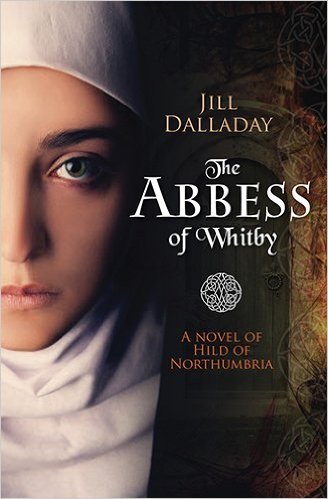 Synopsis: The dramatic story of a seventh-century evangelist. Chosen as Eostre’s handmaid, Hild will serve the fertility goddess for a year before being wed. Her future is predictable―until King Edwin claims her as kin and she learns that her father was murdered.
Synopsis: The dramatic story of a seventh-century evangelist. Chosen as Eostre’s handmaid, Hild will serve the fertility goddess for a year before being wed. Her future is predictable―until King Edwin claims her as kin and she learns that her father was murdered.Her first love is given a command in Edwin’s forces and vanishes from her life, wed to her sister. The court is baptized, ending the old religion and Hild’s role. Life looks bleak. She can’t stop wondering who killed her father.
Suspecting Edwin, she challenges him, only to be married off to safeguard his northern frontier. Struggling in a loveless marriage, she is intrigued by the Iona priests making pilgrimages to spread Christ’s love. When home and family are lost in Oswy’s sack of Edinburgh, she finds herself in enemy hands, but meets the charismatic Aidan. Inspired and guided by him, she builds communities to live and teach Christ’s love. She attracts followers. Even her old enemy, King Oswy, entrusts his child to her, gives her Whitby, and seeks her help to reconcile divisions in his kingdom. She never ceases battling against old superstitions resurrected by storm, plague, and solar eclipse, but at last she receives a bishop’s blessing―from a man she trained herself.
Writing about a woman in the Dark Ages, is no easy feat, as record keeping, especially when it came to women, was rare indeed. To recreate the path of a woman's life requires a painstaking piecing together of facts along with the author's imagination. In The Abbess of Whitby, the author has succeeding in blending fact with fiction to recreate Hild of Northumbria's life. With its stunning cover, Hild's story is a compelling one. As the daughter of the king's nephew, she is chosen as a handmaiden to the queen. She loses favor when she questions the king regarding whether he had a hand at poisoning and murdering her father. The king marries her off to a very difficult, hard man. Her life is miserable until she learns about Christ and becomes a Christian.
This was an easy read, albeit a little slow at times, but this is typical for biograhical novels. The characters are based on real, colorful persons who lived the historical events described. I have never read a book set in the 7th century, so found it fascinating to learn about this era. More than anything else, this is the story of a fascinating woman who overcame the rigid rules and hardships women faced to gain respect and admiration from the people. A grand tale beautifully told!










Published on March 02, 2016 12:45
March 1, 2016
Julia Ward Howe
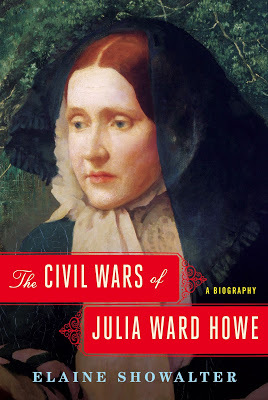 The first full biography of Julia Ward Howe—the author of The Battle Hymn of the Republic and an early and powerful feminist pioneer—a groundbreaking figure in the abolitionist and suffrage movements.
The first full biography of Julia Ward Howe—the author of The Battle Hymn of the Republic and an early and powerful feminist pioneer—a groundbreaking figure in the abolitionist and suffrage movements.Julia Ward (1819–1910) was a heiress and aspiring poet when she married Dr. Samuel Gridley Howe, an internationally-acclaimed pioneer in the education of the blind. Together the Howes knew many of the key figures of their era, from Charles Dickens to John Brown. But he also wasted her inheritance, isolated and discouraged her, and opposed her literary ambitions. Julia persisted, and continued to publish poems and plays while raising six children.
Authorship of the Battle Hymn of the Republic made her celebrated and revered. But Julia was also continuing to fight a civil war at home; she became a pacifist, suffragist, and world traveler. She came into her own as a tireless campaigner for women’s rights and social reform. Esteemed author Elaine Showalter tells the story of Howe’s determined self-creation and brings to life the society she inhabited and the obstacles she overcame.
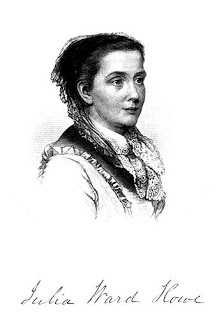 In November 1861, while she was staying at Willard’s Hotel in embattled Washington, DC, Julia Ward Howe wrote the lyrics to the most famous patriotic anthem of the Civil War. “It would be impossible for me to say,” she wrote in her Reminiscences (1899), “how many times I have been called upon to rehearse the circumstances under which I wrote the ‘Battle Hymn of the Republic.’ ”
In November 1861, while she was staying at Willard’s Hotel in embattled Washington, DC, Julia Ward Howe wrote the lyrics to the most famous patriotic anthem of the Civil War. “It would be impossible for me to say,” she wrote in her Reminiscences (1899), “how many times I have been called upon to rehearse the circumstances under which I wrote the ‘Battle Hymn of the Republic.’ ” Indeed, until she died in 1910 at the age of ninety-one, Howe endlessly told and retold the story of how she had come to write the lines that made her famous. Everywhere she traveled or spoke—at a school in St. Paul, a Unitarian church in Chicago, a gathering of black women in New Orleans, or a flower-bedecked Memorial Day celebration in San Francisco—she was expected to read the words of the song, or sing them in her trained contralto; and choruses and soloists around the world enthusiastically honored her by performing it as well. This “oft-told tale,” she noted, had become for many Americans the story of her life.
A century ago, the first biography of Howe, written by three of her daughters, and published in March 1916, just six years after her death, won the Pulitzer Prize. Awarded for the first time in 1917, in the midst of another war, the Pulitzer Prize had a strong moral and nationalistic purpose. Nicholas Butler, the president of Columbia University and the administrator of the awards, called Julia Ward Howe the “best American biography teaching patriotic and unselfish services to the people, illustrated by an eminent example.”
Despite this sanctimonious encomium, the two-volume biography was not as didactic as Butler’s tribute makes it sound. The daughters drew on the Howe family correspondence, plus Julia’s essays, poems, memoir, and journals, to tell a lively story of a woman as charming and funny as she was learned and thoughtful, as devoted to her large family as to public service. Howe was certainly eminent, unselfish, and patriotic. She had six children, learned six languages, published six books; she was a prominent figure in the churches and intellectual societies of Boston; she joined ardently with her husband in the abolitionist struggle; she traveled all over the United States, the Caribbean, and Cuba, and abroad to England, France, Italy, Switzerland, Germany, Holland, Belgium, Greece, Cyprus, Palestine, and Egypt; she founded and led the Association of American Women, served as president for the New England Woman’s Club, the New England Suffrage Association, and the American Woman’s Suffrage Association. Howe was the first woman to be inducted into the American Academy of Arts and Letters.
Born three days after Queen Victoria, she was sometimes called the Queen of America. The daughters also wrote an inspiring story of their parents’ marriage. When she married Dr. Samuel Gridley Howe, Julia Ward was an aspiring poet, a beautiful, accomplished, studious heiress known in New York social circles as “the Diva.” Samuel G. Howe, eighteen years her senior, was a hero of the Greek Revolution of the 1820s and a world- famous doctor who had developed a method for educating blind children; his name, the critic John Jay Chapman noted, “was known to everyone in the civilized world.” Together the Howes were one of the leading power couples of nineteenth-century America, uniting exceptional intelligence, moral fervor, worldly ambition, immense energy, and public commitment. Living in Boston, they knew many of the key literary, political, intellectual, and scientific figures in the Civil War era, including Charles Sumner, Henry Wadsworth Longfellow, Margaret Fuller, and John Brown. They traveled to Europe on steamers as often as modern jet-setters would amass frequent-flyer miles and made friends there as well; Florence Nightingale was the godmother of one of their daughters; Dickens, their guide in London. They were devoted and imaginative parents, and their marriage, in the title of another memoir by their daughter Laura E. Richards, was the fusion of “two noble lives.” But that first biography hid as much as it revealed. In reality, the marriage was turbulent and unstable—a prolonged domestic battle over sex, money, independence, politics, and power. The Howes disagreed, quarreled, separated, often lived and worked apart. Despite his inexhaustible compassion for the suffering, helpless, and deprived, and regardless of his dedication to the abolition of slavery, Howe held obstinate and conservative views on women’s roles in public life. He expected his wife to be completely fulfilled in her domestic and maternal role, and to accept with gratitude his right to make all the decisions about their lives together. A towering figure in the field of philanthropy and social reform, at home he was dictatorial, restless, and touchy about his own authority, “an ordinary man,” as Chapman wrote, “a man of headaches and irritability, a man of doubts and errors.”6 Julia Ward expected to have a partner who would introduce her to his more consequential world of ideas and social reform, and allow her to act in it. She assumed that she would be an equal partner in their decisions and free to develop and pursue her own literary aspirations. She hoped to “write the novel or play of the age.”7 Her husband, however, tried to stop her writing after she published an anonymous book of confessional poems that enraged and humiliated him. He took control of her large fortune, and lost most of it. Throughout most of their marriage, famous and beloved though Julia became, his expectations dominated hers. She had to exercise her power obliquely with the soft feminine weapons of tears, self-sacrifice, unselfishness, domesticity, and maternity. For personal self-expression and public communication, she had to use the conventional medium of lyric poetry, and then even that was eventually denied to her. Nevertheless, in the course of their marriage, she learned how to resist his dictatorship, respect her own needs, and develop, defend, and act upon her convictions—in sum, how to think about the manifold ways that the politics of inequality entered the household. Writing the “Battle Hymn” was the turning point in her life, and its renown gave her the power and the incentive to emancipate herself. The Civil War challenged nineteenth-century ideals of separate spheres for men and women, changed assumptions about gender, and propelled women out of domestic confinement into public lives and careers. In Howe’s case, this transformation was also a rebellion against her marriage. She fought a second civil war at home, battling with her husband over her rights to independence, equality, and a public voice.
After her husband’s death in 1876, Julia was free to forge a new identity. For the second half of her life, she was a leader of the fight for women’s suffrage. She traveled alone or with other suffragists all over the United States campaigning for women’s rights. She became an advocate for the emancipation of the silenced and subjected. Although her children, and then her grandchildren, continued to complain about her extra-domestic activities and attempt to thwart them, Julia insisted on doing what she believed necessary and right. The glorious final decades of her life were a result of the limitations of her marriage and a refutation of its confining bonds. There have been a few excellent biographies since 1916, but there is none that looks at Julia Ward Howe as a major American heroine and sees the marriage of the Howes as a paradigmatic clash of nineteenth- century male and female ambitions. The Civil Wars of Julia Ward Howe tells the story of her battle in that other civil war of emancipation.
“Elaine Showalter is that rarity: a scholar, feminist historian, sharp-eyed cultural critic, with a knack for choosing subjects that are both entertaining and brilliantly illuminating. The Civil Wars of Julia Ward Howe is written with Showalter's usual witty, sparkling, and erudite style. This zestfully narrated life of an early, pioneering feminist, a tireless crusader for social reform and women's rights, would make an ideal PBS series—indeed, all the parts are in place for a felicitous adaptation of Showalter's gem of a biography of a truly remarkable American woman.”—Joyce Carol Oates
“Famous as the author of Battle Hymn of the Republic, Julia Ward Howe had a memorable career beyond this single momentous achievement, as a poet, abolitionist, mother, lecturer, and feminist. Interweaving her public life with Julia's troubled marriage to the domineering Samuel Gridley Howe, this splendid biography shows how Julia emerged from her private tribulations as a stronger and more complete person.”—James McPherson, author of The War that Forged a Nation: Why the Civil War Still Matters
“In this gracefully presented biography of the woman we remember as the author of the nation’s signature hymn, we find ourselves fighting along with Julia Ward Howe as she wages her long struggle for independence as a 19th Century daughter, wife and mother. Only occasionally did she call retreat as she used the reach of the Battle Hymn and the responsibilities assigned to women during the Civil War to wage her own fight for freedom for herself and the women of America.”—Cokie Roberts, author of Capital Dames, The Civil War and the Women of Washington
“Glory! Glory! Hallelujah! At last a full, fine, modern biography of the independent woman whose words reanimated the American Civil War and crowned Lincoln, its greatest hero, with a worthy anthem.”—Harold Holzer, author of Lincoln and the Power of the Press, winner of the Lincoln Prize
“An accomplished literary critic, Elaine Showalter draws on journals and letters to give us a true story worthy of fiction. This finely rendered portrait of the oppressive marriage and inner turmoil that fueled Julia Ward Howe’s writing and her later activism on behalf of women’s suffrage compels a feminist reinterpretation of the iconic Battle Hymn of the Republic. ‘Mine eyes have seen the glory . . .’ takes on entirely new meaning.”—Ellen Chesler, author of Woman of Valor: Margaret Sanger and the Birth Control Movement in America
“Showalter brings Julia Ward Howe alive as a fascinating and powerful woman rather than a legend on a postage stamp—a feminist pioneer who was as witty, engaging, and intrepid as she was scholarly, literary, and enlightened.”—Wendy Martin, Professor of American Literature and American Studies, Claremont Graduate University
“Elaine Showalter has brilliantly narrated the life of Julia Ward Howe, with her unhappy marriage to the famed Samuel Gridley Howe, her dislike of motherhood, and the unpublished novel she wrote about a transgender man. This historical biography is timely, as it shows us the underside of a famed Victorian marriage and how patriarchal attitudes could trap even a powerful woman. The story of how she released herself form the emotional captivity of that marriage through becoming a leader in the woman’s movement is inspiring in our own day of considerable backlash against woman’s rights. The book is beautifully written—and a delight to read.”—Lois W. Banner, Professor Emeritus, History and Gender Studies
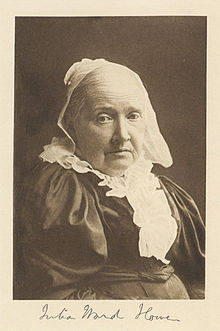 My Review: It is not often that I switch from historical fiction to historical non-fiction, but in the case of this book, THE CIVIL WARS OF JULIA WARD HOWE, I'm glad I did. This book truly read like a novel at times and it was so interesting, that I eagerly flipped pages. Julia was born into wealth, but married a man of the middle class. What began as a loving relationship, slowly turned into a relationship of restriction and oppressiveness for Julia. Her talent as a poet/writer was continually suppressed by her husband. And although he didn't want to have anything to do with her money at first, that changed too, and he began to take advantage by purchasing and selling property with her funds. She was rarely happy and the marriage continued to deteriorate. Nevertheless, despite all her struggles, all the suppression, all the suffocation and stifling she endured, Julia rose courageously. She gained resounding success with her poem THE BATTLE HYMN OF THE REPUBLIC, and acquired great fame as a suffragette fighting for women's rights. She worked tirelessly for her charities too.
My Review: It is not often that I switch from historical fiction to historical non-fiction, but in the case of this book, THE CIVIL WARS OF JULIA WARD HOWE, I'm glad I did. This book truly read like a novel at times and it was so interesting, that I eagerly flipped pages. Julia was born into wealth, but married a man of the middle class. What began as a loving relationship, slowly turned into a relationship of restriction and oppressiveness for Julia. Her talent as a poet/writer was continually suppressed by her husband. And although he didn't want to have anything to do with her money at first, that changed too, and he began to take advantage by purchasing and selling property with her funds. She was rarely happy and the marriage continued to deteriorate. Nevertheless, despite all her struggles, all the suppression, all the suffocation and stifling she endured, Julia rose courageously. She gained resounding success with her poem THE BATTLE HYMN OF THE REPUBLIC, and acquired great fame as a suffragette fighting for women's rights. She worked tirelessly for her charities too. I completely came to admire this wonderful woman and am so proud of her achievements. This book is definitely recommended for women everywhere as it gives us all hope that we can endure and persevere no matter the adversity we may face!










Published on March 01, 2016 07:12
February 25, 2016
Hairstyles of Ancient Times
Today’s hair fashion industry offers women thousands of different haircuts, colors and textures. Women with long and short, thick and thin hair can find something to their task of looking beautiful and attractive. But was it always like this? Could women in
ancient Greece
, for example, change their
hairstyles
every month? Was it possible to change a hair color? Let`s find it out and read fashion hair tendencies of ancient world.
Egypt
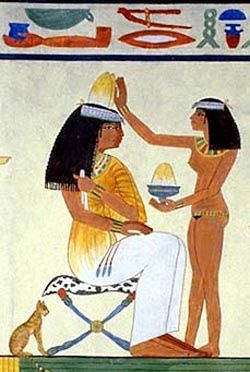
In Egypt woman`s haircuts were like markers of social status, age and wealth. Young girls wore different ponytails and braids. Some of lower classes had to shave their heads clean. With aging, when the first grey strands of hair began to appear, women wore wigs to hide them. Women wore wigs even if they didn’t have grey hair, to hide hair loss. Moreover, wigs helped protect their heads and hair from the burning sun. Shoulder length hair was typical for men and women of Egypt at that time.
Greece
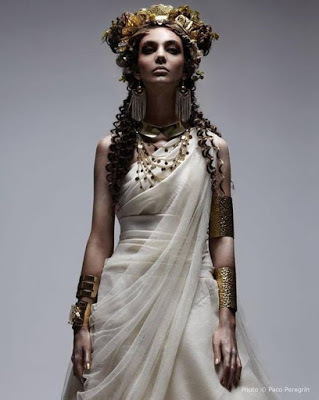
In the country of gods and mythology, women used to pull their hair back into a chignon. It was typical for women to have a long hair, much longer than the length once worn in Egypt. Many hairstyles consisted of different braids and were decorated with flowers, pieces of metal, ribbons and headbands. Greek women loved to dye their hair in red or blonde color, because they were considered to be the rarest hair colors. Ancient Grecian hairstyles also involved sprinkling gold powder into the hair.
China

In China, women`s haircuts and hair length depended on the material status and age of the woman. Older women had very long hair, and it was considered disrespectful for them to cut it. Young girls and unmarried women usually braided their hair. Married women wore high hairdos with several loose curls, as a sign of marriage. Many Chinese women used a hair piece called a Buyao.
Now that you know some of the hair secrets of ancient China, Greece and Egypt, how do you like them? Maybe it would be great to bring these traditions to life again.
See more here http://lerevehairsalon.com/










Egypt

In Egypt woman`s haircuts were like markers of social status, age and wealth. Young girls wore different ponytails and braids. Some of lower classes had to shave their heads clean. With aging, when the first grey strands of hair began to appear, women wore wigs to hide them. Women wore wigs even if they didn’t have grey hair, to hide hair loss. Moreover, wigs helped protect their heads and hair from the burning sun. Shoulder length hair was typical for men and women of Egypt at that time.
Greece

In the country of gods and mythology, women used to pull their hair back into a chignon. It was typical for women to have a long hair, much longer than the length once worn in Egypt. Many hairstyles consisted of different braids and were decorated with flowers, pieces of metal, ribbons and headbands. Greek women loved to dye their hair in red or blonde color, because they were considered to be the rarest hair colors. Ancient Grecian hairstyles also involved sprinkling gold powder into the hair.
China

In China, women`s haircuts and hair length depended on the material status and age of the woman. Older women had very long hair, and it was considered disrespectful for them to cut it. Young girls and unmarried women usually braided their hair. Married women wore high hairdos with several loose curls, as a sign of marriage. Many Chinese women used a hair piece called a Buyao.
Now that you know some of the hair secrets of ancient China, Greece and Egypt, how do you like them? Maybe it would be great to bring these traditions to life again.
See more here http://lerevehairsalon.com/










Published on February 25, 2016 15:45
February 18, 2016
Sultana: The Pomegranate Tree by Lisa J Yarde
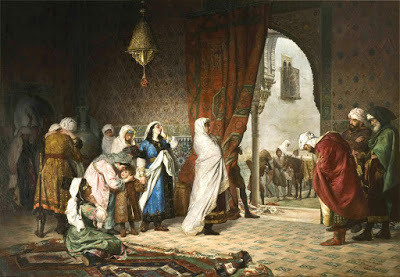
Queen Aisha al-Hurra was married to Ali abu al-Hasan. After numerous machinations and maneuverings, she succeeded in placing her son, Abu ‘Abdullah (Boabdil) also known as Muhammed XII on the throne. For all her efforts, sadly, he lost his power and the kingdom, and became the last Sultan.

Abu ‘Abdullah (Boabdil) Muhammed XII
Aisha's love for her husband faded fast when he abandoned her for a Catholic concubine named Isabella. Isabella later converted to Islam and took the name Zoraya. Having to endure the woman's presence was not the only thing that was worrisome about the relationship. Catholic armies by Queen Isabella and King Ferdinand threatened their sultanate, and the Sultan's love for a Catholic woman made everyone nervous as they feared her influence over him. Her husband's new lover thrust Aisha into direct competition with Zoraya to ensure her sons would not be supplanted by Zoraya's when it came to ascending the throne.
When her husband was away on a prolonged voyage, took matters into her own hands. Aisha set out to turn nobles, citizens, and the military against her husband. In this she succeeded, and saw her eldest son, Boabdil, crowned as the new Sultan.
But Isabella and Ferdinand were eager to seize Granada and make it Catholic. In 1492, they succeeded in driving Aisha and her entire family out. As they all rode out of the city, Boabdil stopped to cast one last look at Granda, taking in beauty for the last time. “Allahu akbar,” he said and then began to weep at all he had lost. Unsympathetic, angry, and disappointed at her son's inability to hang on to power, Aisha responded with, “Weep like a woman for what you could not defend like a man!”
Aisha's poignant biography is re-imagined in Lisa J Yarde's Sultana Series - Book 5 - Sultana: The Pomegranate Tree.
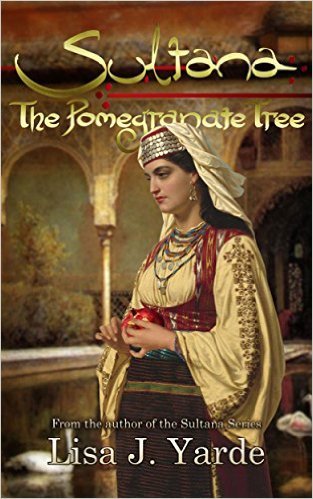 Book #5 of the Sultana series. In fifteenth-century Moorish Spain, Aisha, the descendant of the Sultans of Granada endures a life imperiled by dynastic warfare, loss, and cruel fate. Enemies descend on the kingdom from all sides and threaten to tear it apart. To preserve a fragile peace, Aisha suffers a sham marriage to a cruel tyrant, forever divided from the love that once ruled her heart. Years later, when a trusted confidante becomes a powerful rival, Aisha must fight for the future of the next generation or witness the destruction of her family and the last vestiges of Moorish rule in Spain.
Book #5 of the Sultana series. In fifteenth-century Moorish Spain, Aisha, the descendant of the Sultans of Granada endures a life imperiled by dynastic warfare, loss, and cruel fate. Enemies descend on the kingdom from all sides and threaten to tear it apart. To preserve a fragile peace, Aisha suffers a sham marriage to a cruel tyrant, forever divided from the love that once ruled her heart. Years later, when a trusted confidante becomes a powerful rival, Aisha must fight for the future of the next generation or witness the destruction of her family and the last vestiges of Moorish rule in Spain. Snippet: “I spoke so you would never forget who you are again. You have a proud heritage and Nasrid pride, the pride of lions who lived and ruled for centuries before your existence, and the Sultanas who would not let fate or circumstance bend or break them. Their blood flows in your veins! Saad and his son have taken from you. Show them that you are as fierce as Jazirah, Butayna, Fatima, and even Maryam the viper. As strong as the lioness upon the plains. A lioness of Gharnatah. You have not forgotten. You do not forgive. You shall have recompense for the lives they have ruined and the blood they have shed."
If you are looking for a passionate, gut-wrenching, exotic historical fiction series to read, then start reading The Sultana Series by Lisa J Yarde. Each novel is set in different eras in Moorish Spain. Fastidious research into the family history of the Sultans of Granada and the Nasrid dynasty yielded these utterly compelling and engrossing tales of intrigue, love, massacre, poisonings, and murder. Sultana: The Pomegranate Tree is Book 5 in the series. The main protagonist in this novel is the last queen of Granada, Aisha al-Hurra. Hers became the last generation of the Nasrid dynasty as it was her son who relinquished the kingdom to the Catholic Queen Isabella and King Ferdinand.
Sultana: The Pomegranate Tree depicts the life of Sultana Aisha's rise to power with all the passion and emotion she experienced among the court's intrigues and machinations. As always, the author's uncanny ability to express her heroine's most intimate inner thoughts and aspirations, truly bring to life this fascinating women. Through Aisha's narrative we experience her sense of fairness, her love for her family, her strength and convictions, and all this during a time of political chaos. Aisha lives in the harem in the Al Hambra, a dangerous world, where a wrongly uttered word or a careless act can result in death. Beautifully described surroundings and wonderfully realistic characters evolves into a larger than life tale that is nothing less than page-turning. There are eunuchs, sultans, slaves, concubines, guards, and powerful women who will do anything to garner the attention of the great Sultan and seize power. What I really enjoyed were the many descriptions and small reminders of past history (from past books) sprinkled throughout the story. It helped keep the entire series and history foremost in my mind. Like the other books in the series, this book explores themes of profound love, immense tragedy, deadly rivals, utter betrayal, and ultimate victories. Each story is rich with plot twists and complex characters that fascinate. Lisa Yarde writes with great lyrical beauty and compelling revelations. I have loved each and every books in the series and highly recommend them to everyone.
Thank you to the author and publisher. I received a free copy of this book in exchange for an honest review.










Published on February 18, 2016 13:07
February 16, 2016
The Confessions of X by Suzanne M. Wolfe
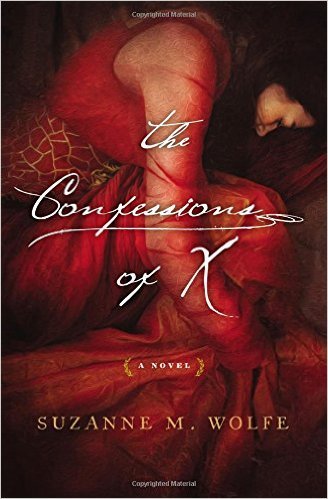 Before he became a father of the Christian Church, Augustine of Hippo loved a woman whose name has been lost to history. This is her story.
She met Augustine in Carthage when she was seventeen. She was the poor daughter of a mosaic-layer; he was a promising student and heir to a fortune. His brilliance and passion intoxicated her, but his social class would be forever beyond her reach. She became his concubine, and by the time he was forced to leave her, she was thirty years old and the mother of his son. And his Confessions show us that he never forgot her. She was the only woman he ever loved.In a society in which classes rarely mingle on equal terms, and an unwed mother can lose her son to the burgeoning career of her ambitious lover, this anonymous woman was a first-hand witness to Augustine’s anguished spiritual journey from secretive religious cultist to the celebrated Bishop of Hippo.Giving voice to one of history’s most mysterious women, The Confessions of X tells the story of Augustine of Hippo’s nameless lover, their relationship before his famous conversion, and her life after his rise to fame. A tale of womanhood, faith, and class at the end of antiquity, The Confessions of X is more than historical fiction . . . it is a timeless story of love and loss in the shadow of a theological giant.
Before he became a father of the Christian Church, Augustine of Hippo loved a woman whose name has been lost to history. This is her story.
She met Augustine in Carthage when she was seventeen. She was the poor daughter of a mosaic-layer; he was a promising student and heir to a fortune. His brilliance and passion intoxicated her, but his social class would be forever beyond her reach. She became his concubine, and by the time he was forced to leave her, she was thirty years old and the mother of his son. And his Confessions show us that he never forgot her. She was the only woman he ever loved.In a society in which classes rarely mingle on equal terms, and an unwed mother can lose her son to the burgeoning career of her ambitious lover, this anonymous woman was a first-hand witness to Augustine’s anguished spiritual journey from secretive religious cultist to the celebrated Bishop of Hippo.Giving voice to one of history’s most mysterious women, The Confessions of X tells the story of Augustine of Hippo’s nameless lover, their relationship before his famous conversion, and her life after his rise to fame. A tale of womanhood, faith, and class at the end of antiquity, The Confessions of X is more than historical fiction . . . it is a timeless story of love and loss in the shadow of a theological giant.
Saint Augustine of Hippo was an early Christian philosopher whose writings had a strong influence on Christianity. He was the Bishop of Hippo in Numidia and is revered as one of the most important Church fathers in history. When he was 19, Augustine fell in love with a young woman of a lower class. Their relationship was forbidden, even though she bore him a son named Adeodatus. His family arranged a marriage to a ten year old heiress, but because she could not marry until the age of twelve, the wedding was postponed. Torn between love and duty, Augustine decided to become a celibate priest, abandoning both women. Who was this woman whom he loved? Her name remains unknown, but it has captured the imagination of historians for centuries. THE CONFESSIONS OF X attempts to shed light on the mystery. Told in the voice of St. Augustine’s concubine, referred to as Una (the One), it is a poignant imagining of her life. The tale opens with her describing their first meeting, their love affair and relationship, the birth of their son, and finally, her life after he abandoned her for religion. I thoroughly loved this book. Its pace flowed steadily, the historic detail splendid. It is the kind of book that sucked me in completely and which I was loathe to put down. Rich with secondary plots and the plight of women who were oppressed by men in this era, it is a book definitely worth reading. I highly recommend it. Definitely a 5 star read!Thank you to the author and publisher. I received a free copy of this book in exchange for an honest review.










Published on February 16, 2016 14:14
February 11, 2016
Beauty Secrets of the Ancient Egyptians
Find out body and hair care secrets the ancient Egyptians used!
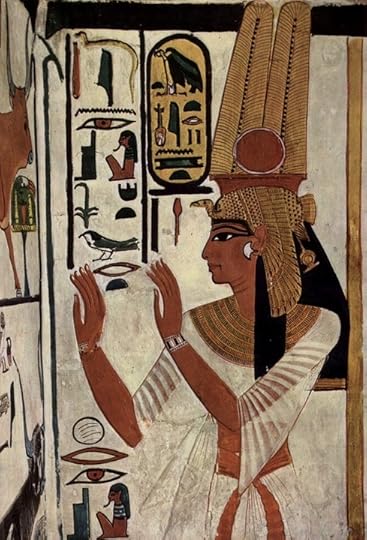
In ancient times in no other country like Egypt, was the concern with body and hair care so extensive. Cleopatra VII wrote a book of beauty secrets, because she was a master of this art. Even today eye makeup styles based on the ancient Egyptian technique are still popular.
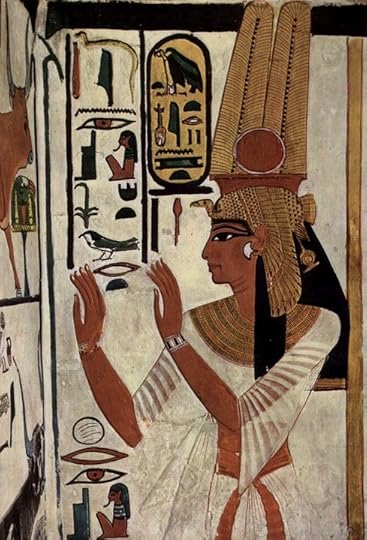
Body care
Body care was a common daily ritual. The ancient Egyptians used body scents for fumigation and flavouring of the body. Women and men also used body oils. They provided skin protection and moisturizing effect in a hot climate. They worried about weight gain and hair loss. The ancient manuscript is entitled «How to Make the Old Young». Such a book could be a best-seller today.Hair CareAs we know, many of the ancient Egyptians wore wigs. It was aimed not only to create a look of beautiful hair, but also to protect people from the heat of the sun. Their own hair was often dyed with henna and braided. They liked to adorn it with lotus flowers, gold tubes, ribbons, petals and berries. Researchers have discovered that people used over 20 aromatic oils not only for body but also for hair care.Make upBoth men and women wore makeup to be more attractive. Their makeup techniques made the natural beauty of the face more expressive. They mixed different ingredients with fats and waxes to make the cosmetics. The egyptians colored the lashes, brows and applied eyeshadow around the eyes. They used different pigments such as malachite to outline the eyes, galena or lead sulfide so-called kohl as the eyeliner, the spice saffron as the eyeshadow. Red ochre and wine helped to add color to lips and cheeks.
So, we can copy a lot from the ancient Egyptians. First of all, their regular application of natural oils for body and hair care.
This is a guest post from Viki Howell. More tips for your beauty here http://hairsalonprestige.com/











In ancient times in no other country like Egypt, was the concern with body and hair care so extensive. Cleopatra VII wrote a book of beauty secrets, because she was a master of this art. Even today eye makeup styles based on the ancient Egyptian technique are still popular.

Body care
Body care was a common daily ritual. The ancient Egyptians used body scents for fumigation and flavouring of the body. Women and men also used body oils. They provided skin protection and moisturizing effect in a hot climate. They worried about weight gain and hair loss. The ancient manuscript is entitled «How to Make the Old Young». Such a book could be a best-seller today.Hair CareAs we know, many of the ancient Egyptians wore wigs. It was aimed not only to create a look of beautiful hair, but also to protect people from the heat of the sun. Their own hair was often dyed with henna and braided. They liked to adorn it with lotus flowers, gold tubes, ribbons, petals and berries. Researchers have discovered that people used over 20 aromatic oils not only for body but also for hair care.Make upBoth men and women wore makeup to be more attractive. Their makeup techniques made the natural beauty of the face more expressive. They mixed different ingredients with fats and waxes to make the cosmetics. The egyptians colored the lashes, brows and applied eyeshadow around the eyes. They used different pigments such as malachite to outline the eyes, galena or lead sulfide so-called kohl as the eyeliner, the spice saffron as the eyeshadow. Red ochre and wine helped to add color to lips and cheeks.
So, we can copy a lot from the ancient Egyptians. First of all, their regular application of natural oils for body and hair care.
This is a guest post from Viki Howell. More tips for your beauty here http://hairsalonprestige.com/










Published on February 11, 2016 10:36



